Montana Bighorn Sheep Hunt 2014
January 25, 2015 1:01 amProbably the pinnacle big game animal for most hunters is pursuing the Rocky Mountain bighorn ram. My dream for hunting these monarchs started in the early 1980’s when I began hunting mule deer in earnest in the Plains, Montana area. Many of my hunting trips were on Pat’s Knob; the mountain directly behind my house. Though I live on the north side of the mountain, most of the deer hunting was on the more open south side where big bucks liked to hang out, especially during the rut. Often I would see more sheep in this area than mule deer during those years. Though I was putting in for a sheep tag for this unit, it wouldn’t be until 2014 that I finally drew a tag.
One of the big attractions for me to hunt this mountain is the limited accessibility. Hunters have only a couple of choices to enter this area. There is a Forest Service road that goes all the way to the top of the mountain from the north side where there are communications towers and a Forest Service lookout. Hunters can drop off of the mountain in many places and hunt on down to the river. The 14 Mile Trail is a FS maintained trail and gets hunters into the middle of good sheep territory.
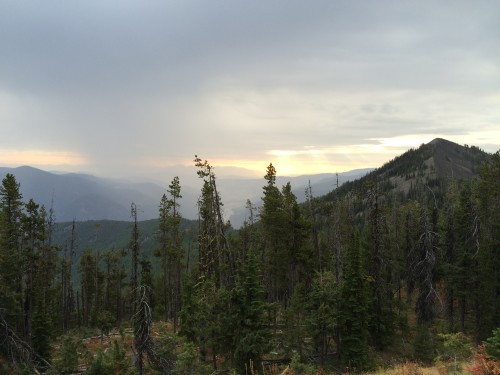
High on the mountain while hunting down to the river in late September.

Part of the upper section of the 14 Mile Trail during an October snow storm.
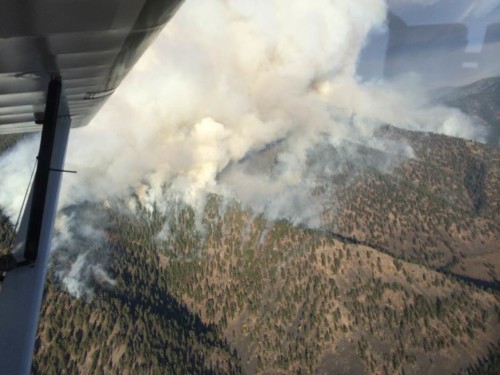
The Forest Service burned this part of the mountain a few days prior to the October snow event to improve habitat. I bumped into the FS District Ranger on the 14 Mile Trail a day before the burn and he told me that the Wild Sheep Foundation was paying for the costs associated with the burn.
On the south side of the mountain, the highway bridge commonly known as the 14 Mile Bridge, crosses the Clark Fork River and allows access to the Pat’s Knob side of the river from the bottom up. There is also a railroad bridge a couple of miles downstream that some hunters occasionally cross on foot. The other option is to park at one of the many highway pullouts along this stretch and put a boat, kayak or canoe in the river and paddle over the sheep’s side of the river. This appealed to me and was my usual way to cross when I went looking sheep. This method was also nearly the end of me. But I’ll tell that part of the story later.
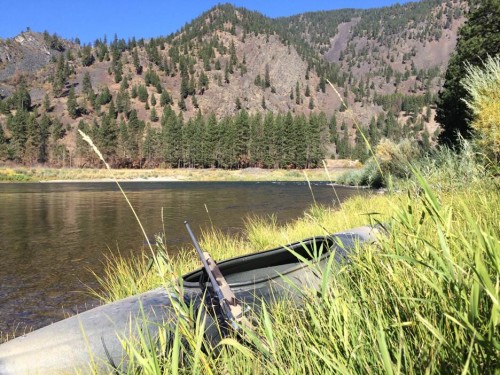
It was about a half mile downstream from this spot where I shot my ram. This is my little kayak and the lightweight 7mm-08 built on a Nesika action, Lilja #1 contour barrel, Nightforce 2.5×10 scope and McMillan stock. It weighs about 7 pounds with ammo in the magazine.
I was fortunate to have some experience hunting sheep prior to this hunt. In 1989 my wife drew a ewe tag for Pat’s Knob and she made quick work of that, hunting just one day. At that time there were more sheep on the mountain (and no wolves) and getting a ewe was easy. A year or two later I also drew a second-choice ewe tag for the Paradise herd. And in 1997 I successfully hunted a Dall ram in Alaska. But this bighorn hunt was special. Something I’d hoped would come to be for more than 30 years.
Probably because I live so close to the hunt area, I started looking for a ram in September. That and being excited about sheep hunting again. The conditions then were not favorable. It was too hot, with afternoon temperatures in the 80’s. But September soon rolled into October and I continued looking for the ram I wanted. I was hunting mostly from the bottom up now, rather than from the top down, as I had been doing when it was warmer. I was seeing sheep, but the bigger rams were elusive. Climbs of 1000-2000 feet were the norm and my 57 year old legs and lungs were working hard.

It was hot on this early October day that my son Carson and I looked for sheep.
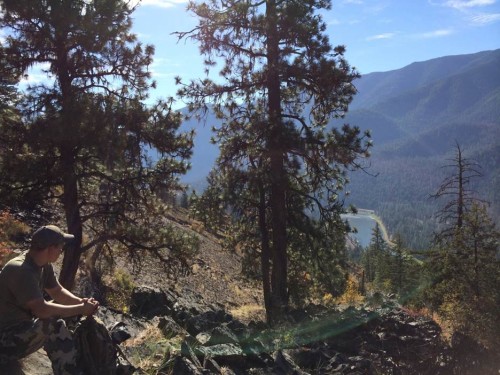
Carson, taking a break as we climb up from the river looking for sheep early on in the season.
Once November arrived though, the rut started to come into play and the rams began showing up. As it worked out, November 7th was to be the day – one day after my 58th birthday. I’d talked to my nephew Richard the evening before and we agreed to meet on the highway at daylight and start glassing for rams. This was our first time out together since I got the tag. Richard is a building contractor, part time hunting guide, and had a big building project going on as well as a September moose hunt in Alaska and a Montana Missouri Breaks elk tag. So it didn’t work out to hunt together until the 7th. We started seeing sheep and rams right away that morning, and I made a river crossing in my kayak to get a better look at a couple of rams with ewes we saw near Quinn’s resort. The rams were a little too small and I was soon back to the highway via kayak. We worked our way upstream, stopping at all of the pullouts on the highway and glassing for rams across the river on the rugged lower reaches of the mountain. And we were seeing them too but none that we got excited about. That changed once we got a little upstream from Camp Bighorn. We saw some ewes low on the mountain and Richard briefly saw two rams a little higher up working their way toward the ewes. Soon they were with the other sheep, and we knew immediately that I needed to cross the river for a good look and perhaps a shot. The big ram I estimated was in the mid to high 180’s and the smaller ram was roughly 10” less. The biggest rams I’d seen so far.
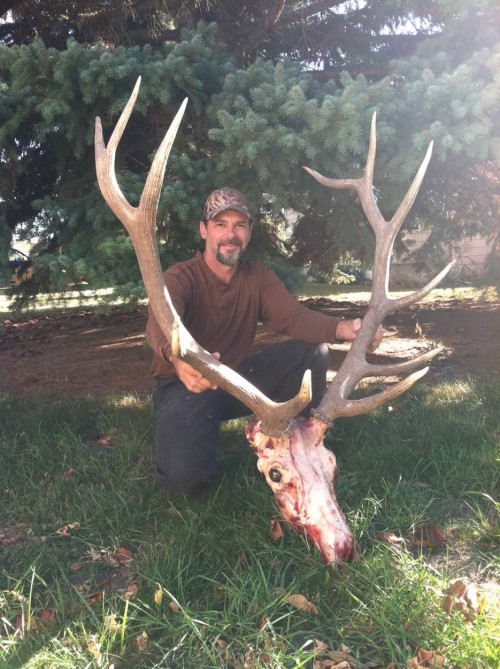
Richard with a bull he shot during the 2014 season in the Missouri Breaks.
Like all sheep hunters, I had outside pressures to “get my ram”. I had taken off quite a bit of time from work to chase sheep earlier in the season. After all, this is most likely a once-in-a-lifetime hunt for any Montana bighorn hunter. Complicating this further, though, I had also drawn a fourth season Colorado mule deer tag and that 5-day season opened on the 12th of the month. The weather was also forecast to get bitterly cold two days later. And I hadn’t been able to spend much time hunting deer and elk……..and so it goes. Would this be the day?
The highway sits fairly high above the river in this location and it is a jumble of big boulders to the river. Together we carried the little kayak down to the water. I routinely put my rifle in first and my day pack on top of it. Richard said he was going back to our original location where he could keep a better eye on the sheep. I slipped into the kayak like I had many times before and pushed off. Foolishly I had not been wearing a life jacket when I made these short crossings. It was at most a five minute paddle and I simply didn’t bother with one.
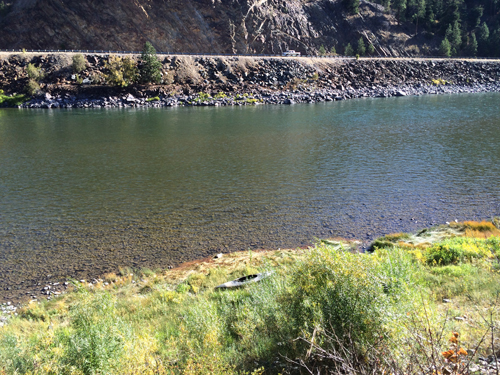
This image is upstream from where I had the incident. But the river banks are similar here. My truck is parked on the highway side and in the foreground my kayak is pulled up out of the river.
This part of the river narrows, and though not a whitewater stretch, it does support a 100 yard stretch of standing waves, probably caused by big boulders deep below the surface. It looked fine to me though, and I nosed the kayak into main flow of the river. The moment I entered the standing waves, my world turned upside down, very wet, very cold and very dark. The kayak flipped in the blink of an eye and I was tossed out. The first sensation was a numbing cold penetrating my hunting clothes. I soon surfaced kicking my way up. The river is fast, deep and dark here and the kayak was about 15 feet away from me. I was still in the swift water but the kayak had shot over to the slacker water on the highway side of the river.
It was during this period of what was probably just a couple of minutes that I didn’t think I was going to survive. I thought my time was up. I needed to swim to the kayak, now upside down, to save my life. My clothes were soaked with November-cold water and I was dressed with climbing boots, rain pants and a camo Gortex jacket and orange vest. This made swimming all the more difficult. I didn’t panic though, even after taking on a little water through my mouth. My mind was simply telling me to complete the immediate job at hand which was to swim to the kayak. I wasn’t thinking beyond that.
Once I did get to the kayak, I put my arm into the now-underwater opening and held on with one arm while I kicked and swam with my free arm back toward the highway, maybe 75′ away. It seemed like I wasn’t getting any closer to the rocks as the current swished us along. It appeared as though I was just getting quickly carried downstream but not getting closer to the bank. The cold was getting to me. I knew I had just minutes of strength left. But again I felt calm. Once I got into the slower water closer to the rocks it seemed like I was making progress again and finally I was back to the rocks. It is steep enough and the boulders so large here that I stood upright on a rock in the water and held on to another at chest level with just my head and shoulders above the water. But I’d made it! I was experienced at scrambling up boulder fields and though the submerged rocks were slippery I was able to claw myself up and out of the river. I had also kept a grip on the kayak rope.
A very appropriate Bible verse was pointed out to me later: Isaiah 43:1-2. I thank God I was able to keep my ‘cool’ and not panic, that he gave me the strength to swim back to the kayak and then to the rocks. Without his providential hand I’m sure I would no longer be here.
About this time Richard loomed above me with very pale face. Later he told me that he had not seen me flip but must have looked upstream immediately afterwards to check on my progress. All he could see was the kayak floating along upside down but nothing of me. He thought I was gone and felt completely helpless. Soon though, he saw my hand surface and then my head bobbing along. He dashed over to where he thought I might reach the bank and got there just after I made it to the boulders. Together then we got the kayak lifted out and flipped over and though I hadn’t had time to wonder about them, to my amazement there was my pack and rifle still in the draining kayak! I didn’t even realize until later in the day; my glasses had stayed on my head through all of this.
The opening in the kayak is fairly small and when I made crossings I placed my rifle in the bottom of the kayak first and put my Badlands pack on top of it. I half-sat on the pack and folded-down seat back while I paddled. The pack had stayed jammed under the back part of the kayak and kept the rifle from slipping out. We carried the kayak and gear back up to my truck over the boulders. As I stood there shivering in the 40º air temperature, a shook-up Richard asked me what I wanted to do? I thought for a moment, looked back across the river to where the sheep were and through chattering teeth told him: “I’m going to drive home and get some dry clothes on. I’ll be back in about an hour. You keep an eye on the sheep and I’ll go back over there and kill one.” And so I did. From where we were parked it is about a 20 minute drive to my house. I ran inside the house stripping off my wet clothes as I entered in front of my shocked wife, explaining what had happened and what I was planning to do. She gave me a hug and told me to be careful. She knew this was important to me.
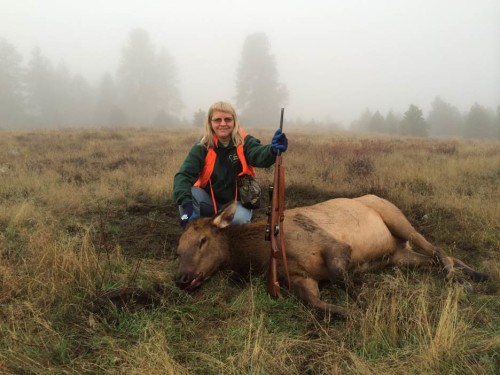
Here she is with a cow elk we snuck up to in the fog on the morning of opening day. She is a hunter too and wanted me to get the ram I was after.
On the way out I got another kayak paddle (the only loss in the river upset) and a life vest from the shop and blew my rifle out with the air compressor. I was back to the sheep area in a little over an hour and Richard told me they were still where they’d been while I went swimming. This time we launched the kayak a little farther downstream in flat water. I wondered if I’d be apprehensive during this crossing but I got across without worry or problems.
The sheep were still low on the mountain, no more than 500’ above the river. There was a sharp ridge about 250-300 yards downstream from the sheep and it looked like climbing up to it was my best opportunity for a shot. The ridge would put me at about the same elevation as where we’d last seen them. To get up to this knife-edge ridge meant climbing a boulder field. I preferred to climb through the boulders rather than smaller and looser talus, and was soon atop the ridge.
Finding a crack in the steep-sloping rock for my feet to get a bite on, I peeked over and didn’t see sheep where I expected them. Soon though, I spotted two rams lying on a tilted rock ledge. The bigger of the two was lying straight away from me. Wow, his bases looked big at 300 yards through my binoculars. But was it the biggest of the two rams we’d seen earlier? The other ram in the open was obviously a smaller ram and not one of the two that initially got our interest. I needed to wait until the bigger ram turned his head so I could judge his curl and mass farther out on the horn. It was probably a good 15 minutes before he showed me that view. And when he did it was because he was now up and walking. Was he going to leave? Did they sense my presence? In the short time he gave me side looks, I didn’t think it was the big boy. Though a very nice ram, I didn’t think he was the biggest one we’d seen earlier. Did it matter at this point? I’d come very close to dying a few hours earlier. All of the thoughts and pressures I mentioned above came to mind. But where was the bigger one? I’d passed up a couple of rams earlier in the season that would be close to this one in front of me. Should I shoot this fellow now or continue to hunt for the biggest ram? If I didn’t find him today it could be two weeks before I’d be able to hunt sheep again. That would leave not-so-many days before the season closed. I’d already hunted more than 25 days.
Another thought came to mind. Richard said we’d have no trouble finding a ram after my Colorado trip if need be. He lives close and was happy to help. But then he threw in a comment that went something like this: “We can find a big ram over here later in the month. There’s always a few showing up down low then. But then you’ve got those other hunters with tags picking them off.” Boy, that didn’t help.
I decided it didn’t matter at this point.
I knew my rifle well. It is a custom 7mm-08 shooting a 150 gr. Nosler Ballistic Tip at about 2800 fps. I knew where to hold with the Nightforce 2.5-10 NXS scope at 300 yards. Using my fanny pack as a rest I put the scope dot where it needed to be on the now broadside ram and squeezed the trigger. Usually I can hear a bullet hit an animal at this range but I didn’t this time. But there was no need to confirm the shot by sound. The ram instantly collapsed and slid down the 50’ sloping ledge and then free-fell for another 50’ coming to dead stop in the boulder field. I couldn’t see his final position from where I’d shot though. It took me a good ten to fifteen minutes to get to him picking my way over boulders and little cliffs. When I did get there I felt a huge sense of relief. I thanked God for a fantastic day on a fantastic hunt!

Here we are. My ram and a happy looking sheep hunter. This is where he landed after free-falling from above. I had started to cape him when Richard arrived and took this picture. That’s what the nasty looking cut mid-body is and why the cape looks loose. The Nightforce scope was completely water-free and performed flawlessly after being submerged in the cold river and being banged around in the kayak and over the rocks. This is an original 2.5-10×24 NXS scope and has been tossed around a lot more than what it got on this day. Very tough scopes.
I started the dismembering and caping job and was about half finished when I heard some rocks falling below me. Richard’s always smiling face soon came into view as he climbed up with our pack frames. He’d found a row boat and came across with his dad. His dad took the boat back across the river and two of the guys I work with, Cory and Rich, then came over to our side with their packs too. We soon had the ram lashed down to pack frames and worked our way down the boulders back to the river.
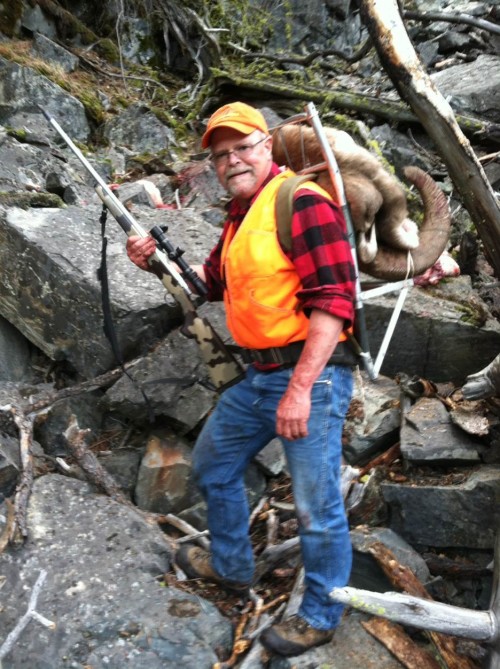
A happy sheep hunter packing a ram out. Thanks to my friends Richard, Richard and Cory for helping. Soon it would have been dark without their help.
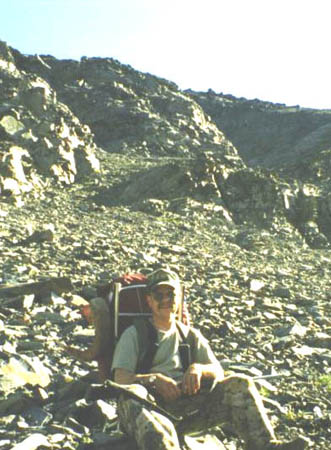
This is a scanned image from 17 years earlier with me packing out my Dall ram from 1997. The same pack frame too.
So how big was this ram and what happened to the bigger one? I haven’t put a tape measure on him. When I got the ram plugged by Montana FW&P biologist Bruce Sterling he measured the bases at 15 ½” and the horn length at 36 ½”. The two horn bases almost touch each other in the center. My estimate is he’s in the mid 170’s. But to me it does not matter. He is 7 1/2 years old, so though not an old-timer, he is a mature animal in his prime. He’s my ram and the second biggest one I saw in 26 days of looking and glassing about 25-30 rams. When I was crossing the boulder field to get to the ram I shot, I saw a few ewes in the trees well above me. I assume the bigger boy was with them.
Predators have taken a toll on the sheep on this mountain, in my opinion. When I first started hunting this area in the early 1980’s there were a lot more sheep prowling around. Big rams of 180-195 were common then. Now it is tough to find one that makes that magic 180 B&C minimum. Mountain lions have always killed a few sheep here and continue to do so. But wolves are the new predator and seem to be intent on keeping the sheep numbers suppressed. One of the guys I work with jumped six wolves on Pat’s Knob a couple of weeks after I shot the ram. They had killed 7 bighorns. The next day he went back to same general area and found another kill zone with too many parts and horns to know how many had been killed.
Sheep like steep, rough and rugged country. This mountain has plenty of all of these features. I made trips up the mountain into places where I found I could get into trouble easily. I always wore my Badlands internal frame pack and carried essentials like water, rope, knife, spotting scope, a lunch, dry socks and a few other things. More than once I found myself ascending or descending a cliffy area on a narrow sloped ledge. At times these ledges take you where you want to go and at times they peter out into nothing and it becomes necessary to backtrack. But with a cliff face on the uphill side and often the downhill side too and a narrow ledge, it isn’t possible to turn around. The pack pushes you outward as you try to turn, hitting the cliff face, and if you turn with the weight of the pack on the outside, the center of gravity change seems to pulling you out into never, never land. So the only choice, at least for me, was to back down the ledge to a point where a safe turn could be made.
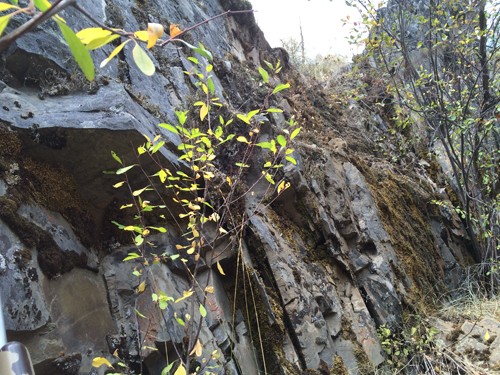
This is a passable slot in a cliff but some aren’t.
And a few times I made trips down the mountain after a rain or snow made everything slippery. I had to watch my footing on every step or I’d have fallen. I did take a few spills on the rocks and once banged my scope pretty hard. Later that day I made a quick trip to the rifle range and checked my zero. The tough NightForce NXS scope hadn’t budged though.
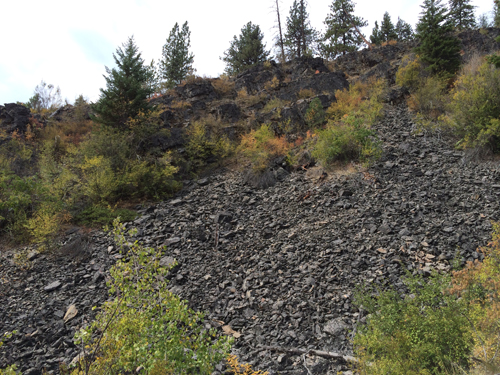
Places like this get very slippery when the ground is wet and worse with snow.
A few lessons learned are; wear a life jacket when crossing hazardous water in cold weather. We kayak on this river a lot in the summer and I don’t wear a vest then. But I’m dressed for swimming and the water is a comfortable temperature. Don’t get too serious about hunting rams until November. Thank God for all of his many blessings every day and know where you’re going to go if you don’t survive.
Looking back on the swimming experience now I certainly wouldn’t call it fun but it was an adventurous expereince and I like adventure and challenges. I really enjoyed reading the book Dangerous River by Robert Patterson. In my crossing I was no longer living a dangerous river dunking vicariously through a book. This was my own experience and I wouldn’t trade it for a tamer hunt. My vision of hunting sheep on this mountain from 30 plus years ago had come true.
Post Script: In April of 2015 Montana Fish, Wildlife & Parks closed the season two weeks prior to the application deadline for sheep in this hunting district. In a helicopter survey that month only 18 sheep were counted. The blame was put on disease in the herd the last two years, most likely from domestic sheep. I’d add wolves and the trains to their demise. As I mentioned in this story; there were not nearly as many sheep to be found as there was in years past.

And yes, I did get a mule deer buck. He’s about a quarter inch short of that benchmark 30” width.

